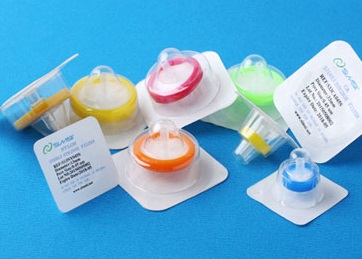Syringe filters are the filters that are used for removing impurities and dirt from any liquid or gaseous substance that is to be used for quality analysis such as HPLC, ion chromatography, gas chromatography, and dissolution testing. These are made for single use only. Disposable syringe filters are efficient and purify the substance faster. Syringe filters are matched by two compositions i.e. diameter of filter, and pore size. We are here with the different syringe filters at affordable prices.
How to use a syringe filter
A syringe filter is also known as a wheel filter is for one-time use only. It is a membrane-based filter container, to be attached with a syringe to get rid of impurities from liquid solutions. These filtered sources are used as samples, purification of these samples is necessary to prevent the instruments from destroying. Disposable syringe filters are used in abundance for quick and efficient purification. These are also used for sterilizing solutions<250 ml. it is paramount that the appropriate selection of syringe filters has been done to ensure unwavering testing results and best performance. Some parameters you need to check for making a good choice i.e. membrane diameter, materials, pore size, and housing.
How to choose the equitable syringe filter
Just to get predictive results, it’s necessary to choose the right syringe filter. First of all, check whether your application needs to be pre-filtered or not. If the pre-filtration is needed then choose the suitable membrane type for the purification. The selection of membrane type depends on the type of solution. For example, if the solution is aqueous then you can use either nylon or MCE membrane filters. If the solution is non-polar then nylon, PTFE, PVDF are these types of filters that can be used. If the solution is made up of protein then PVDF, PES is the best-suited syringe filter for it.
Choose the best-suited diameter for the syringe filter. The volume could be less than 10 ml to 250 ml and 13mm to 33mm.
Choose the pore size accordingly; you need to check the size of the particle before going towards the choice of syringe filters.
Check the solution is sterile or non-sterile
Syringe filters are used to remove impurities or unwanted particles from a solution. Both the solutions can be used depending on the processing application. If a sterilized solution is required, a sterile syringe assure you to get the predictive result without contamination.
If a non-sterile solution is to be purified then a non-sterile syringe will give you the optimal results.
How to use a syringe filter?
Syringe filters are generally used in laboratories, sometimes these filters can create improvident issues like leaking of a sample, filter breakage, filter falling off the syringe. These are some of the instructions which you can keep in mind while using.
Step1 Open the bowels
Open the packaging of a syringe and remove the needle. The volume of the syringe depends on the samples to be filtered.
Step2 fix membrane filter to syringe
Collect a small amount of air in the syringe before loading the sample. Attach the filter securely in a clockwise motion.
Step3 protect the syringe filter
Protect the syringe while applying to the syringe. Do not over-tighten the filter while putting on the syringe.
Step4 purify the solution
Hold the amassed syringe filter and purify it. Purify the solution into the receiving bottle.
Step5 dump the filter
Remove and dump the filter from a syringe.
Conclusion
These were some of the key points that might be helpful for you. It will help you in using the membrane filters. Whenever you are choosing the syringe filters for any of the experiments. Make sure you are reminded of all the suggestions to get the exact filter you were searching for. Thanks for visiting.


